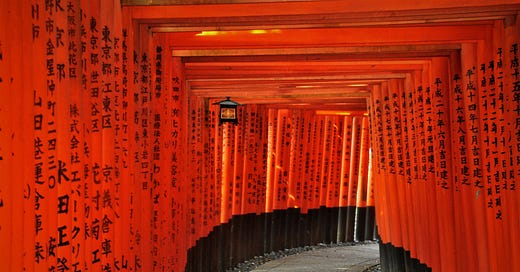Everyone has heard of Shintō. You know the bright red torii (鳥居) which separate the secular from the sacred. You have probably visited famous tourist sites such as Ise Shrine, Itsukushima, or Fushimi Inari — the place in the picture above with a lot of torii.
What you probably ignore is that, just as there is a whole corpus of Christian philosophy behind Notre-Dame de Paris, there is an important philosophical tradition behind these famous Japanese shrines and sanctuaries.
Endemic thought in Japan is of two kinds. It encompasses:
A corpus of ideas that were more or less strictly born in Japan.
A corpus of ideas that, while originating in other parts of the world, have developed uniquely in Japan and become something distinct, like a river that cannot be fully explained by its source.
The religion of Shintō is special in that it corresponds more to the first case than does Confucianism and Buddhism, which derive an important part of their doctrines from foreign corpora of ideas. In fact, the term Shintō usually refers to the religious beliefs that existed in Japan before the importation of Buddhism.
However, Shintō is not easy to approach. First, it has not been studied as extensively as Buddhism. Second, it is not easy for the 21st-century eye to distinguish between religious beliefs and what has been (re)framed by political ideology. Third, political ideology itself may require a plural, “political ideologies,” to represent the various ideological conceptions that have influenced what we now call Shintō.
In a notice of the Stanford Encyclopedia of Philosophy, Thomas Kasulis writes about Shintō:
In its archaic form, especially before its contact with the literary philosophical heritage of continental Asia, it is better termed proto-Shintō because it only loosely resembles what we now know as Shintō. Institutional Shintō thought did not significantly begin until the medieval period and today’s Shintō philosophy mostly originates in the Native Studies tradition beginning in the eighteenth century. That trajectory of Shintō doctrinal development continued with the rise of nationalism and ethnocentrism under the rubric of Shrine Shintō, the institutional arm of State Shintō ideology, which cast a pall on creative philosophical thinking from the early twentieth century until 1945. Postwar Japan has witnessed a range of renewed Shintō philosophies, some in the direction of a return to right-wing ideology, others toward a more liberalized version inspired by Western models of liberal Christian theology and comparative religious scholarship. (“Japanese Philosophy,” 2022)
What is important here is the progressive development of what we call Shintō today. Starting from its early proto-development, Shinto has gone through several distinct eras, including institutionalization, nationalism and ethnocentrism, and state Shintō.
During this development, Shintō was influenced by elements of foreign cultures that were integrated into Japanese culture. It was also influenced by the political context with tensions concerning internal and external politics, that is, outside and inside what we now call Japan. In other words, Shintō was also used to respond to local demands and to differentiate local cultures from continental ones, especially from China.
In such a complex history, and in order to approach Shintō’s philosophy, we will begin with the concept of Kami (神), which is the most fundamental, which seems self-evident, but is not. We will then try to understand where these Kamicome from, especially by contrasting Shintō and Western views. We will continue by reflecting on the behavior of Kamiin an attempt to grasp the connection between ethics and cosmological views in Shintō. Finally, we will offer some general reflections on Shintō.
Do you really know what a Kami is?
What characterizes proto-Shintō is its diversity. There was no single and homogeneous proto-Shintō, but rather a variety of thoughts and practices. There were a variety of places of worship in a geographical area that we cannot even call Japan at that time because there was no state of Japan yet.
From such a beginning, what remains throughout the history of Shintō, from proto-Shintō to contemporary Shintō, is the concept of Kami (神, spirit or divinity), which even gives its name to Shintō (神道), a word that literally means the “way of Kami.”
In her 2017 study, Shinto: A History, Helen Hardacre explains:
From earliest times, the Japanese people have worshipped Kami. Kami may be the spirits of a particular place or natural forces like wind, rivers, and mountains. Kami such as these would neither be regarded anthropomorphically nor be seen as embodying moral principles. Some are intimidating, and not all of them are good to humans. Only under Buddhist influence did the Kami come to be conceptualized anthropomorphically. Figures of myth, such as the Sun Goddess Amaterasu Ōmikami, make up a distinctive group of Kami. Other Kami, such as Inari, associated with agriculture and commercial success, grew out of communal customs and have no textual basis. Some Kami originated as the deified spirits of human beings, such as the Heian period courtier Sugawara no Michizane (845– 903), apotheosized as Tenjin. In the early modern era, feudal lords, peasant martyrs, and founders of new religious movements were deified as Kami. In the modern period, the spirits of the war dead were apotheosized, and the idea of the emperor’s divinity was promoted, not only by Shinto but also through such influential institutions as the schools and the military. (Shintō: A History, p. 1)
Three periods can be distinguished in the development of the concept of Kami. A period in which Kami were spirits worshipped as natural elements. They were not considered to be human or to look like human beings.
Keep reading with a 7-day free trial
Subscribe to Philosophy and Beyond to keep reading this post and get 7 days of free access to the full post archives.




